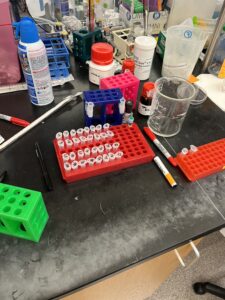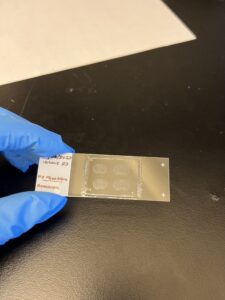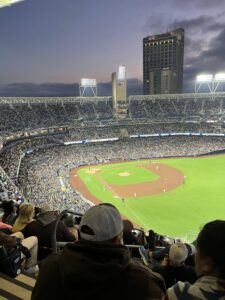Hello everyone! I’m Melaina Yender and this is my fourth week researching neuroscience and click chemistry at the Ye Lab at Scripps Research Institute in San Diego, California. I have been conducting research with my mentors on the binding of hallucinogenic drugs in the brain through the process of clearing-assisted tissue click chemistry (CATCH).
This week was very short due to the holiday at the beginning of the week. Thursday and Friday were the most busy as I completed multiple experiments in just two days. The first experiment I conducted was creating a click reaction for some samples that were imaged the previous week that had some abnormal fluorescent signals in the vehicle samples. This is typically abnormal as the vehicle (control) lacks any drug for the fluorescent tags to click to. My mentors wanted to see if that was coming from the click reaction or if it was from the tissue itself. I began by selecting four tissue samples from the vehicle brain with the intention of making a click reaction for only two of them in order to later conclude where the fluorescence was coming from. I selected two samples from an anterior bregma (around 0.5) and the other two samples from a posterior bregma and did the reaction for one of those tissues each. After the reaction finished, I mounted the slides and imaged them using confocal microscopy. The imaging was congruent with the previous results which was quite puzzling. My mentors decided to run the experiment again on Friday and modify the dosing amount and injection times. The original experiment was a pre-blocking experiment for the drug Salvinorin A. The purpose of this is to see if the modified drug probe of the parental drug Salvinorin A is accurate. It is required to test to see if the probe has the same specificity and drug targets as the parental drug to know if that probe can actually be used to mimic the probe. This is tested by injecting the parental drug into the mouse and then following up with an injection of the probe. This is done because the parental drug will bind to the receptors in the brain and therefore occupy the binding pockets. When the probe is injected, there should be no place for the probe to bind to the intended receptors because the parental drug is already there. Then once the tissue is stained and the click reaction takes place, all of the probe molecules that are remaining in the brain will be stained. Once the tissue is imaged, any probe molecules that bound to receptors in the brain will be seen through the fluorescent tag. If there are signals in the tissue, it means that the probe is bonded to different receptors in the brain and is not accurate to the parental drug. The goal is to not see any fluorescent signals in the tissue. With the Salvinorin A Pre-blocking experiment specifically, three mice were injected with the parental drug then followed later with the probe, three mice were injected with just the probe, three mice were injected with another drug then followed with the injection of the probe, and finally, three mice were used as the control. Another drug was used in the Pre-blocking experiment to see if the parental drug is actually blocking the binding pockets in the neuron receptors. This specific drug binds to kappa opioid receptors (KOR) which are the same receptors Salvinorin A binds to. Injections and perfusions were completed at the end of the week, and the rest of the CATCH process for the samples will be finished this upcoming week with Clarity clearing and click reaction processes.

All 32 samples prepared for electrophoresis
My mentors and I conducted the Electrochem experiment again with probes of the drugs DMT, LSD, and Clozapine. It was very exciting to run an experiment with new drugs and see if the experiment will run better with them. It was hypothesized that the probes previously used were not sufficient enough for the experiment, so we are using new drugs to experiment with. The experiment was modified once again in hopes of getting better results. This process took a lot of time as there were a total of 32 samples to create a reaction for and to run through electrophoresis gel. Once we get the results this week, we can conclude if the modifications to the procedure benefited the process and if the new drugs can make this experiment work.
At the end of the week, I went on a run with my mentor Ben through the UCSD campus. It was great to get a chance to be outside of the lab for a while and to explore the campus. Outside of working in the lab, I went to see fireworks for the Fourth of July at Mission Bay with the other interns. It was a beautiful show and we all enjoyed it! I also went to see the San Diego Padres play the New York Mets at Petco Park Saturday evening with Natalie and Giada. This week was wonderful and I’m looking forward to my last two weeks!



That was a lot of samples to create reactions for! That had to take forever or at least seem like it ! Wow, what a great game to see for your first Major league game! I bet it was amazing! And your pictures of the fireworks were fantastic! You take after your Mom for taking pictures! Love you lots! It’s been great face timing with you and your mom. Take care of you!